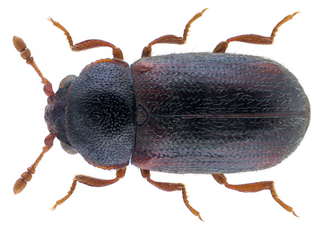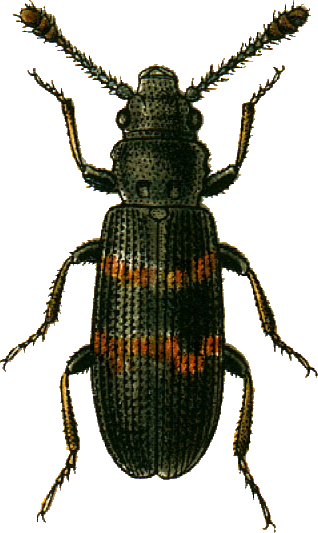
The telephone-pole beetle is a beetle native to the eastern United States, and the only living representative of the otherwise extinct family Micromalthidae. They have an unusual life cycle involving asexually reproducing (parthenogenetic) female larvae, as well as non-functional "ghost adults".

The soldier beetles (Cantharidae) are relatively soft-bodied, straight-sided beetles. They are cosmopolitan in distribution. One of the first described species has a color pattern reminiscent of the red coats of early British soldiers, hence the common name. They are also known commonly as leatherwings because of their soft elytra.

Kateretidae also known as short-winged flower beetles are a family of beetles in the superfamily Cucujoidea. There are 10 extant and 4 extinct genera, and at least 40 described species. They are found worldwide except in New Zealand. Adults are anthophagous, feeding on flowers, while the larvae are spermatophagous inside the flower corolla.

Sphindidae is a family of beetles, in the suborder Polyphaga. They are also known as slime mold beetles due to their exclusive feeding on slime molds during adult and larval stages, other aspects of their life history are obscure. Palaeontological discoveries since 2015 have added to the geologic history of Sphindidae, including the discovery of Libanopsis, placed in the extinct subfamily Libanopsinae.

Helotidae is a family of beetles, in the suborder Polyphaga. The family includes about five extant genera, Helota MacLeay, Neohelota Ohta, Afrohelotina Kirejtshuk, Metahelotella Kirejtshuk, and Strophohelota Kirejtshuk. Helotidae are found mainly in the Old World tropics and are absent from Australia and Madagascar. The antennae are clubbed on the final three segments and is retractable within grooves under the head. The wings have reduced venation with just 4 anal veins. Helotids are known to be associated with sap, fruit and flowers, and the larvae of some species are known to bore into wood in order to pupate.

Phloeostichidae is a family of beetles in the superfamily Cucujoidea. They are typically found under the bark of dead trees. Larvae have been found to consume plant tissue and some fungus, while the adults appear to be exclusively fungivores. The family contains four extant genera, Phloeostichus is native to the Palearctic, Rhopalobrachium is native to central-southern South America and eastern Australia, Hymaea is native to southeastern Australia, and Bunyastichus is found in Tasmania.
Brachypsectra fulva is a species of beetle in the Brachypsectridae family commonly known as the Texas beetle.

Monotomidae is a family of beetles in the superfamily Cucujoidea. The family is found worldwide, with approximately 240 species in 33 genera. The ecological habits of the family are diverse, with different members of the group being found under tree bark, in decaying vegetation, on flowers and in ant nests. Their ecology is obscure, while at least some species are mycophagous, feeding on the fruiting bodies of ascomycete fungi, Rhyzophagus are predators on bark beetles and possibly Phoridae larvae, with the larvae of some species also being mycophagous.

Eucnemidae, or false click beetles, are a family of elateroid beetles including about 1700 species distributed worldwide.

Elmidae, commonly known as riffle beetles, is a family of beetles in the superfamily Byrrhoidea described by John Curtis in 1830. Both adults and larvae are usually aquatic, living under rocks in fast-flowing shallow areas of streams, such as riffles, feeding on algae and biofilms. There are more than 150 genera and 1,500 described species in Elmidae. The oldest record of the group is Cretohypsilara from the Cenomanian aged Burmese amber.

Artematopodidae is a family of soft-bodied plant beetles in the superfamily Elateroidea. They are mostly found in understory forest foliage. The life history of the group is obscure, larvae of the genera Eurypogon and Macropogon likely feed on moss, while the larvae of Artematopus have been fed insect remains.The oldest fossils of the family date to the Middle Jurassic.

Throscidae is a family of elateroid beetles found worldwide with around 150 species in 5 extant genera. The larvae are soil-dwelling, siphoning fluid from mycorrhizae attached to trees. The adults are short-lived, with the adult males being noted for a complex mating dance. Like some other elateroids, they are capable of clicking.
2018 in paleoentomology is a list of new fossil insect taxa that were described during the year 2018, as well as other significant discoveries and events related to paleoentomology that were scheduled to occur during the year.
2019 in paleoentomology is a list of new fossil insect taxa that were described during the year 2019, as well as other significant discoveries and events related to paleoentomology that were scheduled to occur during the year.
2020 in paleoentomology is a list of new fossil insect taxa that were described during the year 2020, as well as other significant discoveries and events related to paleoentomology that were scheduled to occur during the year.
2015 in paleoentomology is a list of new fossil insect taxa that were described during the year 2016, as well as other significant discoveries and events related to paleoentomology that were scheduled to occur during the year.
Echinocups is an extinct genus of Ommatine beetle. It was created in 2020 to house three species originally assigned to Notocupes, E. denticollis, E. neli and E. ohmkuhnlei The genus name refers to the sharp spikes present on the elytra. All three species are known from the Cenomanian aged Burmese amber of Myanmar.
Stegocoleus is an extinct genus of ommatine beetle. Its distinctive morphology includes a distinctive flat rim on the outer edge of the elytra similar to those of Burmocoleus and Jarzembowskiops, but is distinguished from those genera by a distinctive prothorax. It is known from 3 species found in Cenomanian aged Burmese amber.
Burmese amber is fossil resin dating to the early Late Cretaceous Cenomanian age recovered from deposits in the Hukawng Valley of northern Myanmar. It is known for being one of the most diverse Cretaceous age amber paleobiotas, containing rich arthropod fossils, along with uncommon vertebrate fossils and even rare marine inclusions. A mostly complete list of all taxa described up until 2018 can be found in Ross 2018; its supplement Ross 2019b covers most of 2019.
Lepidomma is an extinct genus of ommatid beetle. The genus was first described in 2019 for the species L. tianae. Lepidomma was synonymised with Clessidromma by Kirejtshuk, 2020. This synonymy was disputed by Li et al. (2021), who maintained Lepidomma as a separate genus from Clessidromma. Three additional species of Lepidomma were described in 2020 and 2022. All four species are known from the Cenomanian aged Burmese amber of Myanmar.













